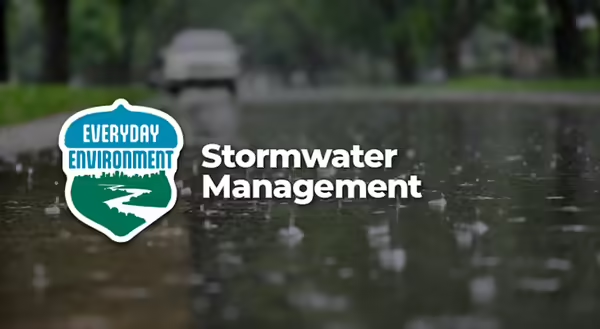
As a child, my friends and I played in a neighborhood stream, catching crawdads. What I didn’t know then was this small waterbody was mainly comprised of stormwater runoff and was connected to everything on our landscape.
What is stormwater runoff?
Stormwater is rain or melted snow that flows off hard surfaces like roofs, roads, and even lawns. In the past, communities mainly focused on managing the quantity of stormwater, directing it away via pipes to prevent flooding. This helped protect property and kept roads passable during storms. However, in many areas, development has outpaced the growth of conventional stormwater systems, and now the pipes don’t have the capacity to carry away all the water during every storm.
There’s also a concern with water quality. Waterbodies connected to conventional stormwater systems are negatively impacted in two main ways:
- Rainwater collected from entire neighborhoods can be powerful enough to erode streambanks during every storm, just like a large storm would have before the system was in place. This creates turbid water and harms aquatic habitat.
- As stormwater moves, it picks up pollutants like bird droppings, car oil, brake dust, lawn care chemicals, and pet waste, and carries them untreated into these waterbodies.
Poor water quality leads to problems like harmful algal blooms and fish kills. It also costs communities more to clean the water to make it safe to drink.
What can be done to improve stormwater?
Building new storm sewers is expensive, so many communities instead are beginning to focus on ways to use water where it lands, freeing up storm sewer capacity and benefiting downstream water quality. Communities also promote ways to reduce pollution, which protects water resources for recreation and other important uses such as drinking water supply.
We all can pitch in to make our waterbodies better for everyone. There are several smart practices that you and your community can do.
Leaves and flowering tree petals: Make sure to clean your storm drain to ensure it’s free of leaves in the autumn and, if you have flowering trees, from petals in the spring. As a homeowner, you can collect leaves from front yards and use them for compost to ensure they don’t get into the street and then, the storm drain. Many communities run a street sweeper to remove leaves before they enter the storm drain.
Lawncare: Use integrated pest management, an approach that limits the use of costly lawn inputs such as pesticides and fertilizers. Consider replacing parts of your lawn with native plants that don’t require these inputs and are much better at soaking up rain.
Green stormwater infrastructure: Consider these multi-functional practices explained below.
What is green stormwater infrastructure?
Green stormwater infrastructure, GSI, is a suite of practices that use or mimic natural processes to manage and clean stormwater. Also known as nature-based solutions, examples are rain gardens, green roofs, permeable pavement, and constructed wetlands, which capture water and let it soak into the ground and/or be filtered by plants and soil. GSI also includes rainwater harvesting, such as rain barrels and cisterns. It reduces stormwater runoff, improves water quality, and helps prevent flooding. It also provides environmental benefits like increasing biodiversity, reducing urban heat, and enhancing community aesthetic value. Unlike conventional systems, which directs stormwater away, GSI utilizes water by allowing it to soak into the ground and replenishing groundwater and/or for immediate or future resource needs, promoting healthier ecosystems. All these techniques can be used in harmony with conventional stormwater systems, helping our communities to grow while protecting natural resources and minimizing flooding risk.
Where can I learn more?
Find more information at our Illinois Groundwork page, and the Rainscaping Education Program. Check out videos showing residential GSI practices at go.illnois.edu/StormwaterHome.
To find out more about stormwater, visit our rainfall management page and consider becoming a Watershed Steward. These are all great steps that you and your communities can take to ensure that future generations have clean water.
Thank you for reading!
Everyday Environment is a series of blogs, podcasts, webinars and videos on exploring the intricate web of connections that tie us to the natural world. Want to listen to us chat about this topic? Check out the podcast episode on this topic to hear more from the Everyday Environment team about stormwater.
Listen to the Podcast Sign Up for Everyday Environment Newsletter